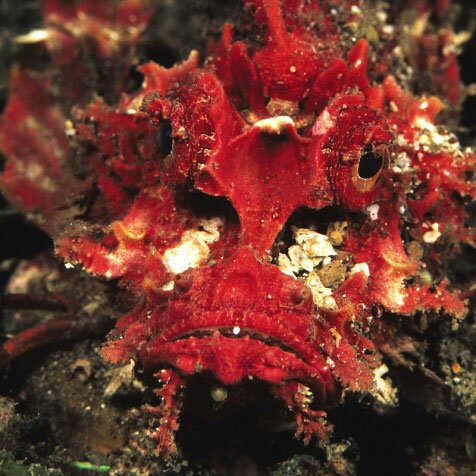Spiny Devilfish
From Microcosm Aquarium Explorer

Incredibly camouflaged, this fish has fearsome stinging abilities. Larry P. Tackett
Overview
This cryptic bottom dweller is notorious in the Indo-Pacific for its ability to inflict excruciating pain on divers and fishermen who come in contact with its venomous spines. (Deaths have been reported.)
A devilfish makes an unusual captive specimen, flaring its colorfully patterned pectoral fins as a warning when threatened. It is a typical ambush predator that will lie quietly in wait of passing prey, then strike with blinding speed. (Do not house with small fishes or ornamental shrimps.)
Family: Scorpaenidae
Other common name(s):
- Bearded Ghoul
- Demon Stinger
- Two-Stick Stingfish
Native range:
Habitat: Sand and rubble bottoms near coral reefs. In the aquarium, it needs plenty of open bottom space and sandy substrate.
Maximum length: 25 cm (10 in)
Minimum aquarium size: 114 L (30 gal)
Water: Marine 24 °C (75 °F) - 28 °C (82 °F)
General swimming level: Bottom.
Feeding
Carnivore. Feed marine fish and crustacean flesh. Live grass shrimp or feeder fish such as mollies may be needed to initiate a feeding response. Some specimens will refuse even live food. Most will eventually take meaty foods presented at the tip of a long, clear-plastic feeding stick. Feed 2–4 times per week.
Aquarium Compatibility
Will hunt and eat ornamental crustaceans and small fishes. Keep only one per aquarium.
Special Care
HIGHLY VENOMOUS. Fatalities have been reported. Not recommended where children or guests can reach into the tank. NOTE: If startled, a devilfish may jump out of the tank. Handle with extreme care and use extraordinary caution when cleaning the aquarium.
Notes
Colors in this species can vary wildly, from the dull to dramatic. The specimen pictured was photographed in Lembeh Strait, Indonesia.
Image by Larry Tackett, coauthor of Reef Life.








